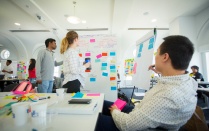Building Skills: Developing a Community
By Katerina Kalyoncu, Nicole Little, Tom Horvath
Refugees are accustomed to insufficient or subsistent levels of existence in regards to various essentials like food, water, and shelter. Oftentimes, these services are dependent on delivery and a traditional model of delivery. The inability to live independent of organizational influences is a major challenge that prevents refugees from experiencing a smooth transition into a new country. The dependency such organizations exists because of conditions that do not empower refugees with the methods of gaining shelter and food independently in new settings. Some organizations provide trainings to refugees, such as the Danish refugee Council (DRC,) which offers training for multiple methods, including vocational, financial, life and protective training. If methods of construction and agriculture were offered or incorporated into training, refugees would be able to build homes that produce food and therefore build independent communities that are self-sustainable.
Integrating agriculture into the well-known system of block construction constitutes as one practice of being self-sustainable. Masonry construction contains blocks which can be made out of mud, clay, or concrete and can be very flexible in size. Arranging the bricks for equivalent light potential, a block wall can be used to plant a multitude of herbs and seeds. Refugees could be trained to be efficient in waterproofing, loading, insulation, botany, and placement to create a green wall with mud bricks, waterproofing and mortar. The benefits of this would be integrating the necessity of shelter with the other necessity of food in one process. The combination not only provides a source of sustenance but also as a source to relieve stress and anxiety that is so common among refugees. Views of green and nature improve depression and anxiety, promoting a calm and positive wellbeing. The disadvantages of the method would be the limitation of growth the walls could handle. Growth in the blocks would may not be enough to feed an entire community.
Another method that can influence self-sustainability with the combination of shelter and food is the rooftop garden system. A green roof provides the opportunity for each family to have their own food source by adding an additional layer to a traditional roof system. Materials of structural wood, insulation, waterproofing, drainage, and soil would be needed to construct the system. Prevention of water leaks into the house, safe load distribution, and understanding green roofing as a thermal insulator are skills that would derive from this training program. Perks of this being present in the community is that the rooftop garden provides as addition space, privacy and security for a family and their food. Presence of this additional layer to the roof can be used as a durable insulation that can prolong the life span of the dwelling and its envelope. In addition, unlike the block construction, rooftop gardens are extremely flexible in what they can grow, allowing refugees a multitude of options that can be unique to each family. The setbacks of a rooftop garden are possible overexposure to light, hazards of weight, and waterproofing and drainage if not constructed correctly.
Another method to promote self-sustainability would be with the development of a trellis to grow food on. This simple construction would be able to support the growth of fruit trees or any climbing plants for refugees to use. Quick training in structure would allow refugees to build an open framework from wood with string and brackets. Pros of this existing in a refugee community would be that it would provide additional food, shading and space, specifically defining the outdoor kitchen spaces. Cons of this method are its maintenance and durability.
Development of a new training program uniting the construction for homes and nourishment into one would assist refugees into creating a self-sustainable community. Training methods of structure, waterproofing, insulation and drainage would be the universal tools needed by refugees to accomplish this goal.

